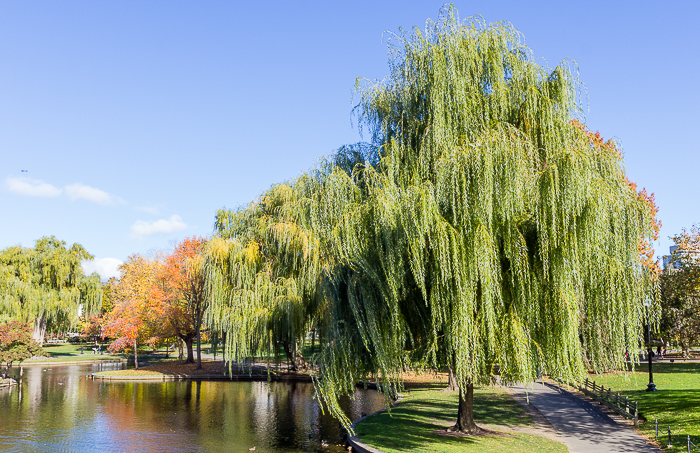
By Margaret Pokorny
Weeping Willow (Salix Babylonica)
The great willows in the Public Garden are the instantly recognizable iconic trees with their curved form and drooping elongated leaves. More than 400 varieties of the weeping willow exist with more than 80 varieties growing in the U.S. This fast-growing tree reaches to 50 feet high and 50 feet wide, prefers a moist location, and tolerates almost any soil. The root systems of willow trees are large, strong, and aggressive and they like to “keep their feet wet”, so their location surrounding the lagoon is perfect. Willows root easily from cuttings and are often the first trees to appear in a disturbed site, giving them the reputation as “healers and renewers.” They contain a chemical that can be used as a rooting hormone to aid propagation. A native of northern China, cuttings were carried and planted along the China trade routes all the way to Egypt. Its scientific name is a slight misnomer. Salix means “willow” but Babylonica was the result of a mistake by Carl Linnaeus, the father of taxonomy, who believed weeping willows were the same willows found by the rivers of Babylon in the Bible. The trees mentioned in the Psalm were thought to be poplars.
Willows were planted around the lagoon in the early 1900’s. Interestingly, it appears that they were not part of the original planting in the Garden as there are no willows in early photographs. All of the weeping willows in the Garden are located around the lagoon, and sadly all of the original plantings have died or been destroyed in storms. The Friends is working hard to care for the existing willows so they will remain healthy. Currently, there are 19 weeping willows in the park.

Public Garden, Pruning a Willow Tree, Dec 2017
Almost all willows take root very readily from cuttings or where broken branches lie on the ground. Perhaps the most famous story of growth from cuttings involves the English poet Alexander Pope, who asked for a twig from a parcel tied with willow twigs sent from Spain to Lady Suffolk. He planted it and legend has it that all of England’s weeping willows are descended from this first one.
At the time of the American Revolution, English General Henry Clinton is said to have brought twigs from Pope’s willow to New England. An additional interesting fact is that General Clinton during his time in Boston resided in John Hancock’s Beacon Street home across from Boston Common. Later, the French government gave branches from the willows near Napoleon’s grave on St. Helena to be planted at the grave of George Washington at Mount Vernon.
In New England, the image of a weeping willow is often found on old gravestones and samplers. The willow appears in Chinese, Japanese, Jewish, Middle Eastern, and European folklore and myths in different guises from a benevolent tree warding off evil spirits to a more sinister presence stalking travelers. The leaves and bark of the willow have been mentioned in ancient texts from Assyria, Egypt and Greece as a medicinal remedy for aches and fever. The tree produces salicin, which is converted to salicylic acid, the primary ingredient in modern-day aspirin. In 1897, a chemist named Felix Hoffman created a synthetic version of salicylic acid which was gentler on the stomach and he produced this new product “aspirin” for his company Bayer.
One verse from the poem In The Willow Shade by Christina Rossetti perfectly describes the allure of this beautiful tree.
O silvery weeping willow tree
With all leaves shivering,
Have you no purpose but to shadow me
Beside this rippled spring?
 Margaret Pokorny is a member of the Friends of the Public Garden Board of Directors and chairs the Commonwealth Avenue Mall Committee. Learn more about Margaret in our Meet the Friends profile.
Margaret Pokorny is a member of the Friends of the Public Garden Board of Directors and chairs the Commonwealth Avenue Mall Committee. Learn more about Margaret in our Meet the Friends profile.

